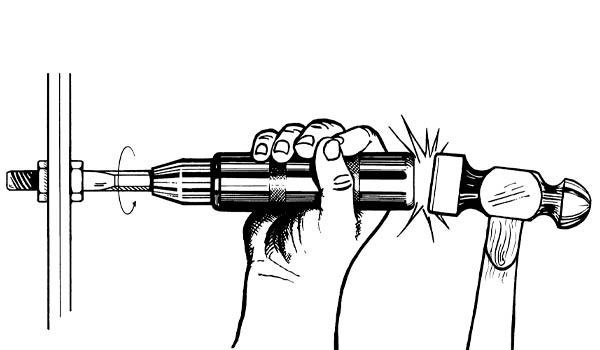How To Remove Rusted Screws

Any screw when exposed to the elements can eventually rust. Choosing the right screw at the start, along with proper maintenance, can help avoid this.
But what if you’re trying to remove a screw from a gate, fence, brickwork, or other object? Perhaps one that has been there for years, or even decades? With the right tools, and some patience you can remove these rusted screws. Rust is just another form of glue, so breaking the bond formed by the rust is the first step.
If the head of the screw is stripped, you’ll want to look at how to remove a stripped screw as well.
How To Remove Rusted Screws: Hammer and Lube

Using a screwdriver and hammer is the first port of call in removing a rusted screw.
- Yu'll need to use a rust penetrant (such as WD-40 Fast Release) available from any major hardware shop. If you don’t have any, a general lubricant will work (such as normal WD-40 or a similar brand), but you may need to repeat these steps a few times.
- Hit the head of the screw with several quick blows with a metal hammer. This helps crack the layers of rust, so your lubricant can get in and do its work. Make sure you don't hit the head hard enough to deform it, just enough to crack the rust.
- After hitting the head of the screw several times, spray a decent amount of lubricant around the screw head. You’ll then need to let it soak in for around 3 minutes. Hit the screw several more times, apply some more lubricant, then let it sit for around 15 minutes.
- Once you’ve let it wait for the 15 minutes or so, hit the head of the screw a few more times.
- Next, gently tap the surface around the screw with your hammer. This lets lubricant travel deeper along the screw thread.
- Now try removing the screw.
If the screwdriver slips out of the screw head or starts stripping the screw head, stop immediately. If you strip the head, we have a handy guide on how to remove stripped screws.
If the normal screwdriver isn’t working for you, you can try using a manual impact driver.
How To Remove Rusted Screws: Impact Driver

- A manual impact driver converts hits from a hammer into a twisting motion force while forcing the bit deeper into the screw head at the same time. That means it reduces the chances of stripping the screw head while increasing your chances of a successful removal. We only recomend using the impact driver if the first option above didn't work.
- We recommend eye protection and gloves. The last thing you want is bits of rush in your eyes, or hands.
- Set the manual impact driver to rotate counter clockwise and choose an bit that fits snugly into the screw head.
- Place the bit in the screw, hold the tool with one hand and strike the impact tool with your hammer.
- Repeat until the screw loosens.
If it still doesn’t move, or starts to strip the head, your only real option will be cutting a slot in the head of the rusted screw.
How To Remove Rusted Screws: Cut a slot
.jpg)
Cutting a new slot allows you to use a large flat blade screw driver to remove a rusted screw.
Philips head screws have a problem, in that they can’t handle a lot of torque without stripping. If your rusted screws remain stuck or you’ve stripped the screw heads, try cutting a notch into each head and removing them with a flat blade screwdriver.
- Still wearing your gloves, cut a new straight slot deep into the screw head using a rotary tool with a metal blade and a cutting wheel. Make sure the slot is wide enough to accept the largest flat blade screwdriver you own while still providing a tight fit.
- Fit the flat tip into the newly made screw slot, and push and turn at the same time.
- If the new screwdriver doesn't work right away, don’t force it. The last thing you want to do is strip the screw further.
This should loosen up the screw. If not, you can carefully try drilling out the head of the screw.
It is slightly more risky method is to drill the head off the screw. Try not to drill deeply, you just want to take the head off enough to be able to remove whatever piece you are trying to remove.
Once the head is off and the piece is removed, enough of the shaft of the screw should be exposed (assuming you didn’t drill it too deep); now use a pair of needle-nose pliers to get the shaft of the screw out.
Once you've removed the rusted screw, you can purchase some new screws here.
